Technology
Kansai International Airport, Japan
Published
2 months agoon
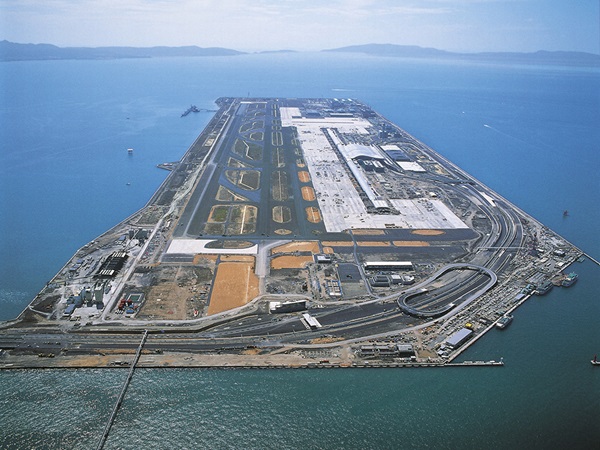

Kansai International Airport, Japan; An artificial terminal on the sea
Osaka Kansai Airport is built on an artificial island in Osaka Bay. This airport was opened in 1994 and its development operation was completed in 2007. It goes without saying that the construction of this airport was by no means an easy task; Although the Japanese are known to do difficult and regular engineering projects in the world. Two mountains were completely razed to the ground for the construction of the island, and according to the Civil Engineering Institute, this airport became the most expensive construction project in the world at the time of its completion.

Despite the amazing engineering achievements such as withstanding earthquakes and strong storms that have been proven by the construction of this structure, in recent years structural problems have emerged in this island airport, most importantly the island is settling at a faster rate than originally predicted, and this has led to It has led to problems such as frequent flooding.
In this article, we will go into details about the background of the airport, construction operations, operation, and of course the future plans of the Japanese government for its development. By reading this article, you can learn about one of the most admirable civil engineering projects in human history, and of course, one of the most amazing airports in the world.
The initial idea for the construction of the airport
Need to build an airport in Osaka
In the 1960s and 1970s, several important events led to the construction of the airport. The first case was the decrease in the share of Osaka and Kobe in the trade market and the prosperity of business in Tokyo. The proposal to build Tokyo’s second airport called Narita was proposed in 1966 and its construction was completed in 1978. Many exporters had to use Tokyo airports instead of local airports to send their goods abroad.
The second case was the low capacity of Osaka’s first airport, Itami. Itami Airport is located in one of the densely populated suburbs of the Osaka metropolitan area. This airport was opened in 1939 and was first used by the Japanese army; But after World War II, the United States Army also used this airport. Since 1959, Itami Airport has been used for civilian purposes, and by carrying out development projects, it became one of the central hubs of international airlines in a short period of time.
Japan’s aviation industry experienced unprecedented growth within 20 to 30 years and since the 60s, the capacity of the Osaka airport alone did not meet the high volume of demand. Due to the location of Itami in the center of a densely populated area, there was no more space for the development of the airport. On the other hand, the noise pollution of the airport and the protests of residents of residential areas caused more problems for the only airport in Osaka. In the 1970s, Itami Airport reached its maximum capacity, and the officials concluded that Osaka needed a new airport.
Choosing a place to build
The construction of the artificial island was not the first option of the airport designers. In the initial plan, it was proposed to build an airport near the port city of Kobe. The construction of the airport in this place could be useful for both cities due to the existence of extensive communication infrastructure. In addition, Kobe did not have an airport. However, the city of Kobe opposed the construction of the airport in this place and the designers had to look for another place to build their airport.
Having learned from the problems encountered for Itami Airport, the designers were looking for a location far from urban areas. In this case, the construction site could advance the construction operation 24 hours a day. Also, the problems encountered in the design of Narita Airport in Tokyo were also one of the main influencing factors in choosing the location of the new Osaka Airport.
In the 1960s, public protests intensified by Osaka residents and landowners, who claimed that they were not consulted during the airport’s design process. On the other hand, the left-wing parties opposed the construction of this airport due to the concern about the expansion of the capitalist system in Japan and greater alliance with the United States of America
The Ministry of Transport of Japan, after reviewing six proposals for the construction of an airport in the sea, decided to build an artificial airport island in Osaka Bay south of the city. In the proposed plan, the island was 4 kilometers long and 2.5 kilometers wide, and it was built at a distance of 5 kilometers from the coast.
The construction of the airport required advanced and complex engineering; Because this airport had to be resistant to earthquakes, storms, and floods. After the approval of the proposed design, the construction of the island started in 1987.
Kanzai International Airport
History of construction of artificial islands in Japan
The idea of building such a large island in a relatively deep bay (the water depth in Osaka Bay reaches 18 meters and its bed is made of soft clay to a depth of 30 meters) may seem ambitious. But Japan has a long history of building artificial land in water or so-called land reclamation; Because land is expensive and scarce in many areas of Japan.
The history of artificial land construction in Osaka Bay dates back to the Edo period (1600-1867 AD) when the land built in the sea was used to plant rice in the coastal plains. However the construction of artificial ground in Japan accelerated after the end of World War II; Because of the rapid increase in Japan’s economic growth, there was a great demand for new land. According to the statistics of the Japan Real Estate Center Construction Company, 0.5% of the land area of Japan is artificial and reclaimed in the sea.
The construction stages of the airport and its infrastructure
Land stabilization
The construction of the airport started in 1987. First of all, the airport land had to be built inside the seawater. The construction of the artificial island took three years, and in order to obtain the required materials, two mountains located near the site of the airport were completely razed to the ground. The airport is actually built on two islands, each of which has a runway and a terminal. Although the construction of the entire airport structure started in 1987; But the first priority of the contractors was to complete Island No. 1, which was completed in 1994. The completion of the construction of the second island took until 2007. The first island with an area of 511 hectares is slightly smaller than the second island with 535 hectares.
The main challenge in building the islands was not the depth of the water but the conditions of the sea bed. The bed of Okasa Bay consists of soft clay, which is also called alluvial clay, and 70% of it is water.
To solve this problem, engineers used the sand drying method. In this method, deep tubes are lowered into the seabed, tubes filled with dry sand. When the pipes are removed from the seabed, the sand columns left behind absorb water from the clay and reduce its ability to shrink. By adding more weight of sand, more clay moisture is absorbed into the sand columns. 2 million sand columns were used to stabilize the Kanzai airport bed.
Despite the measures taken in the field of stabilization and strengthening of the seabed, the island and the airport built on it have settled over time. The creators of the project consulted with several experts to solve this issue, and finally, some estimates were prepared about the amount of airport settlement. According to reports from the University of California, San Jose, the estimates provided by the experts had predicted ground subsidence between 6 and 8 meters after the construction of the airport, so the engineers took the most pessimistic estimate and proceeded with the construction of the project, but as it turned out later, this strategy basically failed. It was wrong.
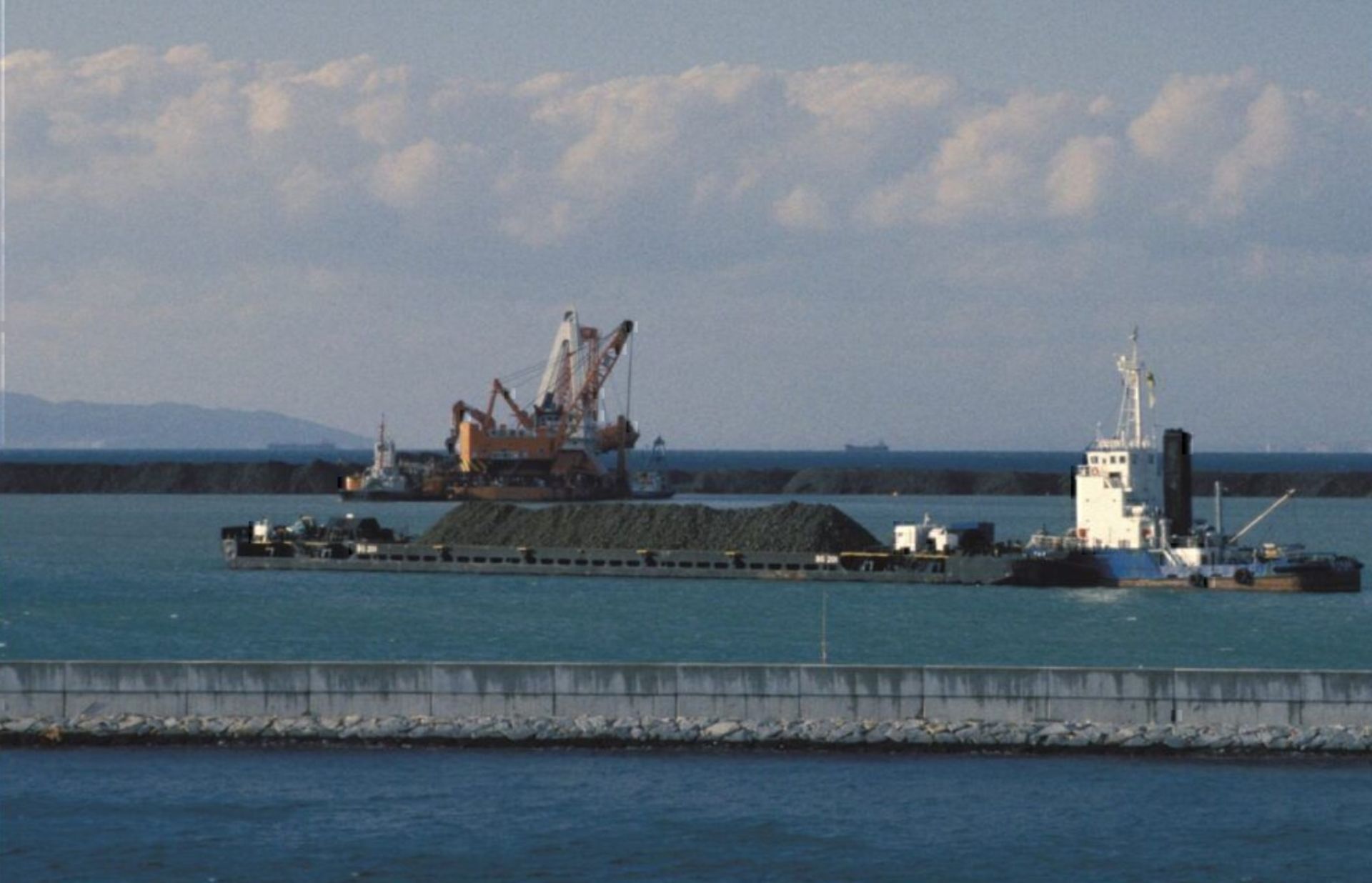
Kansai International Airport
Great land reclamation and island construction operations
After stabilizing the land, the next step was to build a sea wall and fill the reclaimed land. Around the construction site of the island, 69 large metal enclosures were built, and then the space between these enclosures was filled with 48,000 tetrapods. A Tetrapod is a special concrete structure designed to protect structures against waves and surges by dispersing the force of advancing water.
In the next step, the central space of the island was filled with stones. For this work, 430 million cubic meters of stone were used. This amount of stone was extracted from three nearby mountains at a distance of 10 to 30 kilometers from the airport construction site. One of the important points in the construction of the island was its final height. This height should have been calculated based on the estimates of the amount of sedimentation of the clay layer of the seabed. Of course, the subsidence of the bed layer would stop after some time, but the final amount of ground subsidence was not known to anyone.
According to the reports of Geotechnics and Geoenvironment magazine, the final height selected for the first island was 36.7 meters from the seabed, and for the second island, it was 40 to 43 meters.
Start of construction of the airport
The construction work of the airport and terminal facilities of the first island began in 1991 and after the completion of the revitalization of the first island. It should be mentioned that in the first stage, the goal was to build only one runway and one terminal. An Italian architect named Renzo Piano was commissioned to design the main building of Terminal 1. Piano had previously designed the Georges Pompidou National Center for Arts and Culture in Paris. Among his other works, we can mention the Potsdamer Platz square in Berlin and the pyramid-shaped Shard tower in London.
Terminal 1 of Kansai Airport is 1.7 kilometers long, and in this respect, it is called the longest terminal in the world. However, some of the world’s major airport terminals are higher than Kansai Terminal 1 in terms of total area, including the largest terminal in the world, Daxing Airport Terminal. pointed out in the city of Beijing. In the early stages of the construction of the airport structure, the Japanese government intended to shorten the length of the terminal to save costs; But Renzo Piano insisted on building the terminal based on the original plans.
The structural load of the terminal is supported by height-adjustable columns. The design of these columns is such that they compensate for the change in height caused by the settlement of the airport. This work is made possible by placing additional metal plates under the base of the column. The roof of the terminal has a shape similar to an airfoil. This design not only reminds passengers of the shape of an airplane wing; Rather, it helps the smooth passage of air currents over the roof of the terminal.

Connecting the island to the coast
In addition to the island and the airport building, the construction of a communication road between the island and the mainland had to be done. For this purpose, a 3.7-kilometer bridge called the Kanzai International Airport Access Bridge was built. This bridge connects the island to the Rinko section. Rinko is one of the parts of the urban district of Osaka, which itself was built in the 1990s on reclaimed land.
The connecting bridge of Kanzai Airport is a two-story bridge with 6 car lanes, and two rail lines are also built on its lower floor. The construction of this bridge began in 1987 and was completed in 1994 at a cost of one billion dollars.
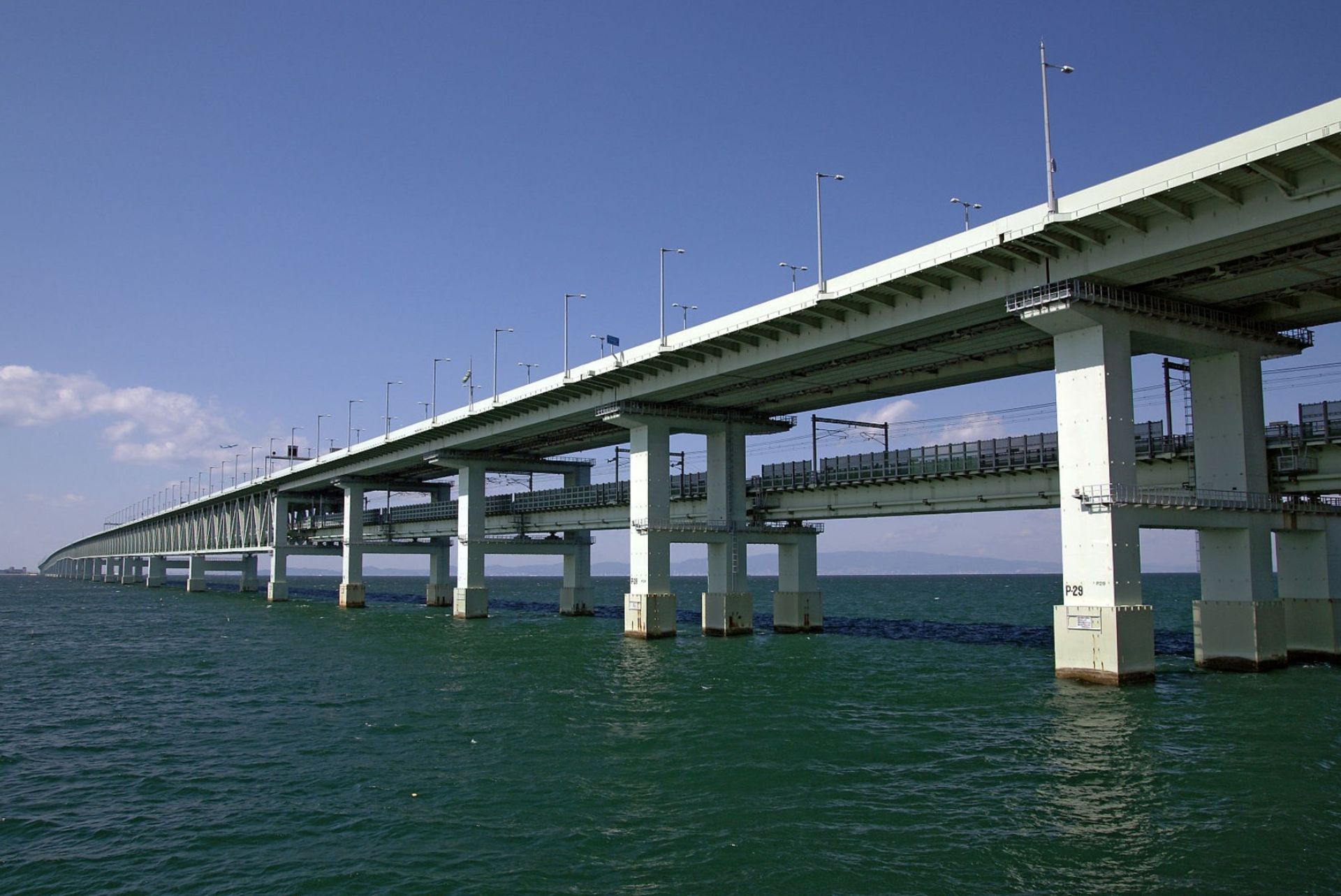
Kansai International Airport
Protests and disturbances in the construction of the airport
Considering the experience of building Tokyo airport and the protests and disturbances that occurred during that project, the officials decided to take all possible measures to prevent a similar incident. Although they were largely successful in doing this by choosing the location of the airport, which was far from densely populated residential areas; But there were still problems along the way of the project. The most important objections to the project came from the local fishing industry; Because after the completion of the construction and operation of the airport, the work of local fishermen was disturbed. However, these protests were ended by an agreement to pay damages to the fishermen. However, there were protests in stone mining workshops, and during these protests, 24 attacks were reported on these workshops.
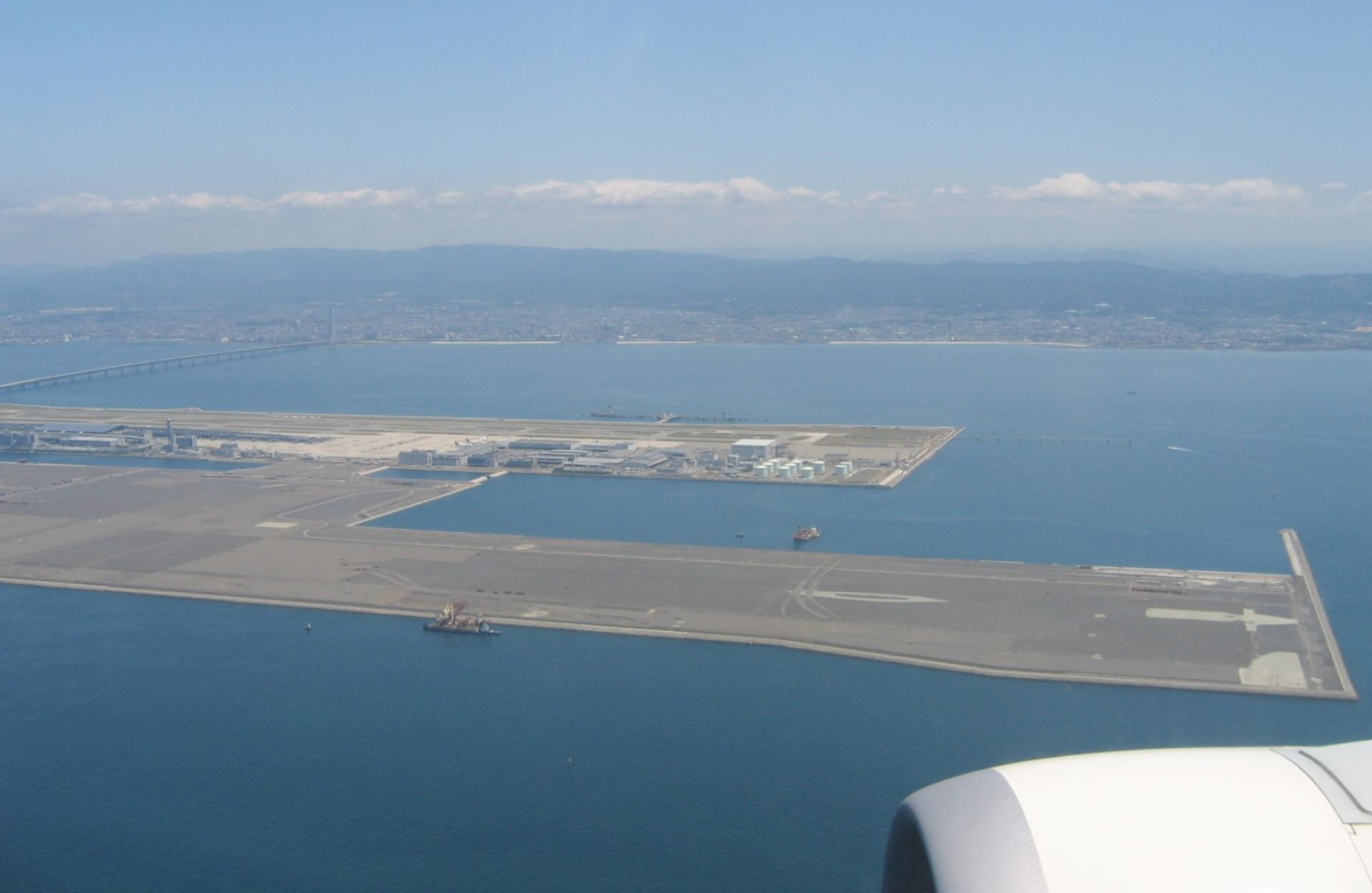
Expanding the airport and building a second runway
The construction of the terminal and the second runway started in 2003. The reason for the delay in starting the second phase of the airport was that the airport contractor could measure the subsidence of the islands during this period. Before the start of the construction of the second landing strip, the issue of the meeting of the islands was more and more in the spotlight; However, due to the completion of Kansai Airport’s capacity during peak hours, the construction of the second landing strip was prioritized, but the construction of the second terminal was delayed.
The construction of the second runway was completed in 2009. This landing strip with a length of 4 kilometers is longer than the first landing strip with a length of 3500 meters. Terminal number two was put into operation in 2012. The building of the second terminal is simpler and more straightforward than the first terminal, it has only one floor and does not have a jet bridge or a bridge connecting to the aircraft. This terminal is specially designed for low-cost flights, where boarding and take-off fees are lower than in Terminal 1.
After the operation of the landing strip and the first terminal of Kansai Airport, more development and repair work was done on the structure of the airport and the island, especially the sea wall. When engineers realized that the airport was sinking faster than estimated, work began on raising the height of the seawall at a cost of $150 million.
Also, more plans have been proposed for the development of the airport, including the construction of a third runway and a cargo terminal. However, these plans have not been implemented yet.
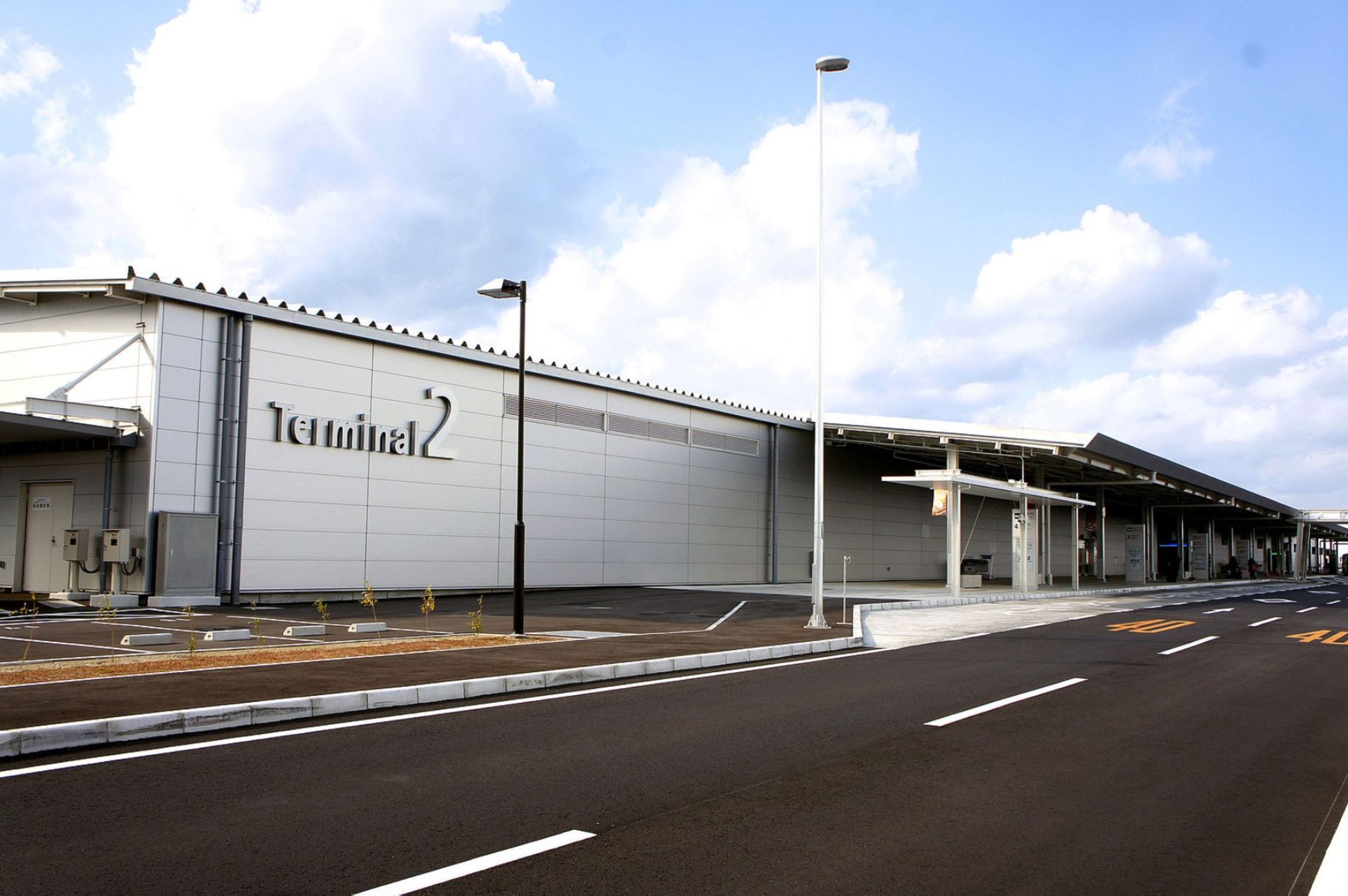
Kansai International Airport
Operation of the airport
Osaka Kansai Airport was put into operation on September 4, 1994. Actually, on this date, only the runway and the first terminal were put into operation; This was while the construction of the second island, followed by the runway and the second terminal, continued. It didn’t take long for Kansai Airport to become the main hub for international flights, while Osaka’s Itami Airport was dedicated to domestic flights only.
But in the first months of the airport’s operation, the high tariffs shocked the airlines. According to a New York Times report in 1993, the Japanese government had increased land rent and airport tariffs to recover the 14 billion dollar cost of building this airport.
The amount of airport tariffs and navigation of Kansai Airport was unique in the world at the time. For example, the cost of landing a Boeing 747 was around 10 thousand dollars. This was while the cost of landing this plane at John F. It was $2,500 in New York and $8,500 in Tokyo’s Narita Airport.

Operation of two airports side by side
Since 1994, Itami Airport has been dedicated to domestic flights only, although there were exceptions; Including charter and special or VIP flights. In order to increase flights at Kansai Airport, the Japanese government imposed restrictions on the operations of Itami Airport; Including the restriction that since 2006, only two-engine planes were allowed to land at Itami Airport.
In 2012, the management of Itami and Kansai airports were merged, however, the management of these two airports was still under the control of the Japanese government. This work improved the services of the two airports, including the operation of inter-airport bus routes and the reduction of Kansai Airport flight tariffs. In 2016, a Japanese private consortium named Kansai Airports won the tender for the operation of Itami and Kansai airports, and the management of these two airports was entrusted to this consortium by the Japanese government for 45 years. In 2018, the operation of Kobe Airport was also added to this contract.
The capacity of the airport to move cargo and passengers
In 2019, Kanzai Airport was the third busiest airport in Japan and the 30th busiest airport in Asia. According to the information published by this airport’s website, the volume of passengers and cargo moved at Osaka Kansai Airport is as follows:
- Number of transferred passengers: 28.8 million people, of which 22 million were international passengers
- The volume of transported cargo: 757 thousand tons
For comparison, consider that in 2018, Narita Airport in the Japanese capital handled 33.4 million passengers and 2.2 million tons of cargo, according to Japanese government data. Maybe Kanzai Airport is not the busiest airport in Asia or Japan, But it can be said that it is one of the most popular destinations for travelers. In 2020, Kansai Airport was ranked the 10th most popular airport in the world and the second most popular airport in the category of medium-sized airports in the list of the best airports in the world. This airport has also won the award for the best airport crew and the best baggage delivery process among all airports in the world.
Kansai International Airport
Coping with hurricanes and earthquakes
The most important point that was considered in the design and construction of Kansai Airport was the severe weather hazards in Japan and the need to protect the airport in these conditions. Perhaps the biggest test that the airport design went through was in January 1995, just one year after the airport was opened when a severe earthquake struck the area. The Kobe earthquake, also known as the Great Hanshin earthquake, was the most severe earthquake in Japan since 1923 and killed 6,000 people. The epicenter of this earthquake was located 20 kilometers away from the airport, and although it caused a lot of damage to buildings further away, almost no damage was done to the airport. Experts attribute this success against the 7-magnitude earthquake to the sliding joints that have been used throughout the airport building.
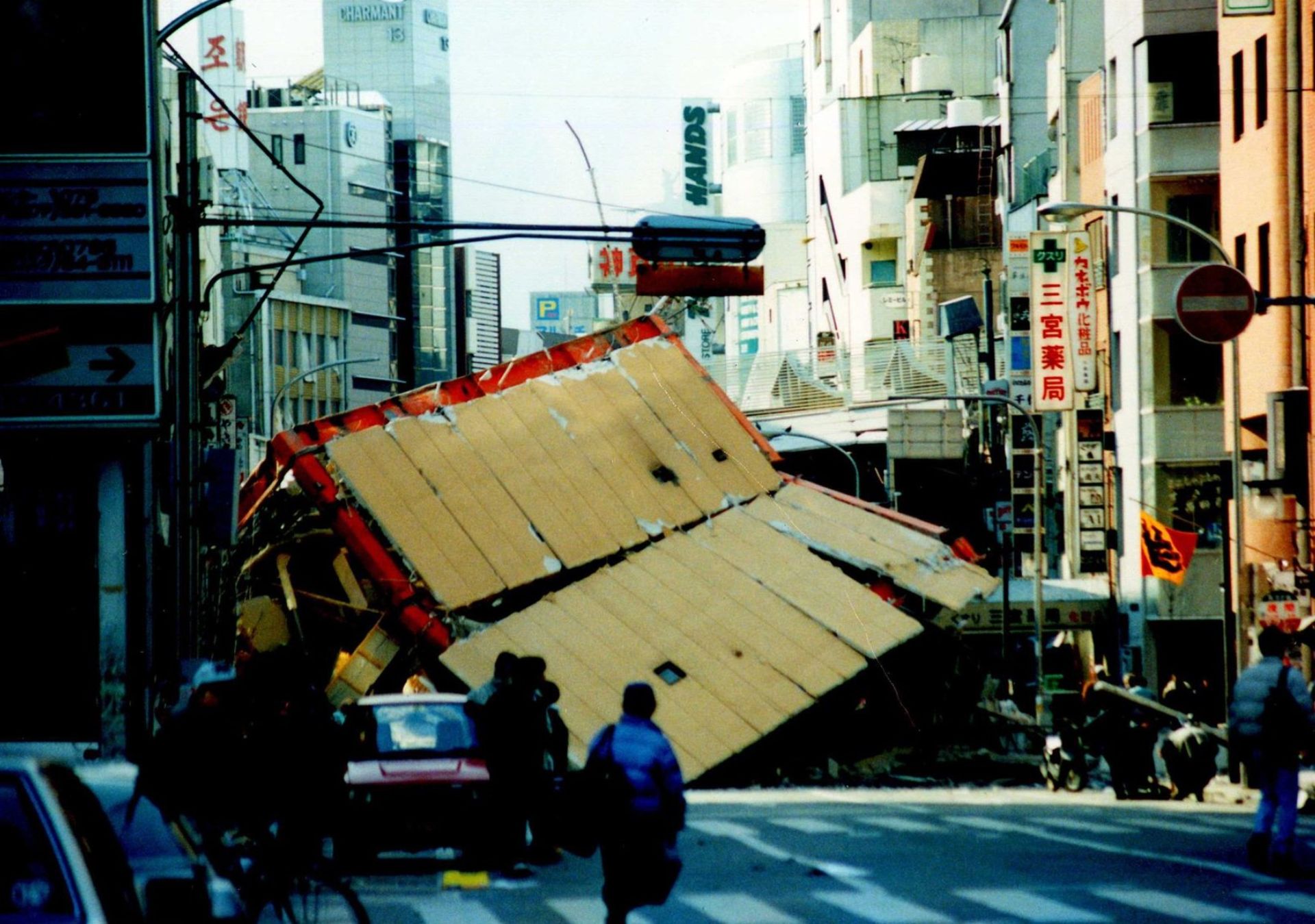
Also, in the past years, Kansai Airport has survived big storms, for example, in 1998, a powerful storm hit the airport with a speed of 210 km/h. In 2018, another terrible typhoon called Typhoon Jebi hit the Osaka area and Kansai Airport. This was the strongest typhoon in Japan since 1993, which caused widespread damage in the Kansai area.
Typhoon Jabi caused high waves in the sea and overflowing of water from the top of the sea walls of the airport, resulting in flooding of the runway, and a tanker ship hitting the airport access bridge caused damage to this bridge. After Typhoon Jabi, it took more than a month for the airport to fully return to operational mode. Although typhoon Jebi was a severe and rare weather hazard, it raised discussions about the problems related to the amount of settlement of the islands and the reduction of the height of the airport.
Is the airport sinking?
Ever since the Kansai Airport construction project was proposed on reclaimed land in the sea, the issue of land subsidence has always occupied the minds of its designers and builders. The airport’s foundation rests on a thick layer of clay, and since the early days of design, there have been varying estimates of how much the island will subside in the coming years.
The method of drying the clay by using the sand columns used to strengthen the seabed causes more settlement of the wet layers that are under the dried layers and are further compressed due to the weight of the island. Of course, it should be mentioned that the weight of the airport building and its planes is almost nothing compared to the huge weight of the stones used to build the island.
According to the International Institute of Civil Engineering, the amount of airport subsidence has decreased from 50 cm in 1994 to 7 cm in 2008.
Reaching the ultimate limit of subsidence
Also, in 2015, a study was conducted on the amount of subsidence of Kansai Airport, the results of which were published in the Journal of Geotechnical and Geoenvironmental Engineering. In the design of the airport, it was predicted that the final amount of subsidence of the island after the stabilization of the soil and reaching the final limit of compression would be such that the airport would be 4 meters above sea level, a height that could still prevent the airport from flooding if the sea walls of the island are destroyed. But this study showed that the first island reached this level of subsidence by 2015 and it is predicted that the second island will reach this level of subsidence between 2023 and 2026. In addition, in the same study, it is predicted that the first island will level with the sea in 2067 and the second island between 2058 and 2100 due to subsidence.
This problem occurred as a result of the design engineers’ incorrect estimation of the actual subsidence of the seabed. Yukako Handa, public relations manager of Kansai Airports Consortium, said in an interview with Air and Space magazine:
During the construction of Kansai Airport, the amount of soil needed to rehabilitate the land in the sea was estimated based on the minimum necessary height and the amount of settlement of the airport after 50 years from the time of its construction.

Different subsidence rates
Another concern raised in Yukako Handa’s interview is the different amounts of subsidence measured in different parts of the airport. For example, in the center of the main terminal of the airport on the first island, the ground is sinking faster than the two ends of the terminal. Before that, a different subsidence rate was recorded in other areas of the island, for this purpose and to prevent cracking and damage to the landing strip, asphalt was used instead of concrete to restore its surface.
Read More: China owns the world’s most powerful supersonic wind tunnel
Kansai International Airport
What is the solution to deal with unexpected subsidence?
Of course, the rate of airport subsidence in the coming years may differ from current estimates, just as the current rate of subsidence differs from initial estimates. The greater risk of subsidence that threatens the airport is the decrease in its height compared to the water level, which means that storms of any intensity can cause water to rise from the sea walls and flood the airport. Not much can be done to solve the root of this problem, But the predictions made during the construction of the airport allow the engineers to take measures to minimize the damage to the airport and the disruption of its operation.
One of these measures can be increasing the height of the sea walls, which was done once before and at a staggering cost. However, other plans have been proposed to further increase the height of the walls. Singapore’s Straits Times reported that the three-year operation to increase the height of Kansai Airport’s sea walls was approved and started in 2019.
In addition, there are plans to increase the height of the runway by adding new layers of asphalt to it. According to the information presented in this Singaporean newspaper, a budget of 510 million dollars (54 billion yen) has been allocated for this airport to carry out measures to prevent the occurrence of disasters, a figure that could increase due to the ongoing projects.

One of the other preventive measures can be increasing the height of the airport building. As mentioned earlier in the article, the foundation columns of the airport building can be adjusted and this is done by inserting metal plates at the base of the columns. According to the report of Irandaspiz magazine, the process of inspecting the columns and changing their height, if necessary, is done by the contractor every two years.
Kansai Airport, one of several island airports
Despite all these problems, Osaka Kansai Airport has been recognized and praised as an important engineering achievement. With the construction of this airport, important experiences were gained that led to the development of engineering methods to overcome the challenge of land subsidence and of course the construction of more island airports.
One of the other important experiences gained from the construction of Kanzai Airport is the importance of the builders’ attention to the costs of such a project. According to estimates made in 2004, the cost of building this airport was estimated at 8 billion, according to the report of Irandaspis magazine. But in 2008, the cost of construction increased to 20 billion dollars, the main cause of which was the problems that arose in the field of land reclamation and the construction of the artificial island.
In the continuation and at the end of this article, we mention other similar important island airports; We will also provide a brief description of Kobe Airport, which is operated jointly with Kansai and Itami Airports under an agreement.
Hong Kong International Airport
Another one of the world’s most important island airports is located in Hong Kong. Hong Kong International Airport, formerly Chek Lap Kok Airport, was opened in 1998 and replaced the old Kai Tak Airport. Kaitak Airport, which started operating in 1925, was surrounded by extensive urban construction and suffered from the same development problems and noise pollution as Itami Airport.
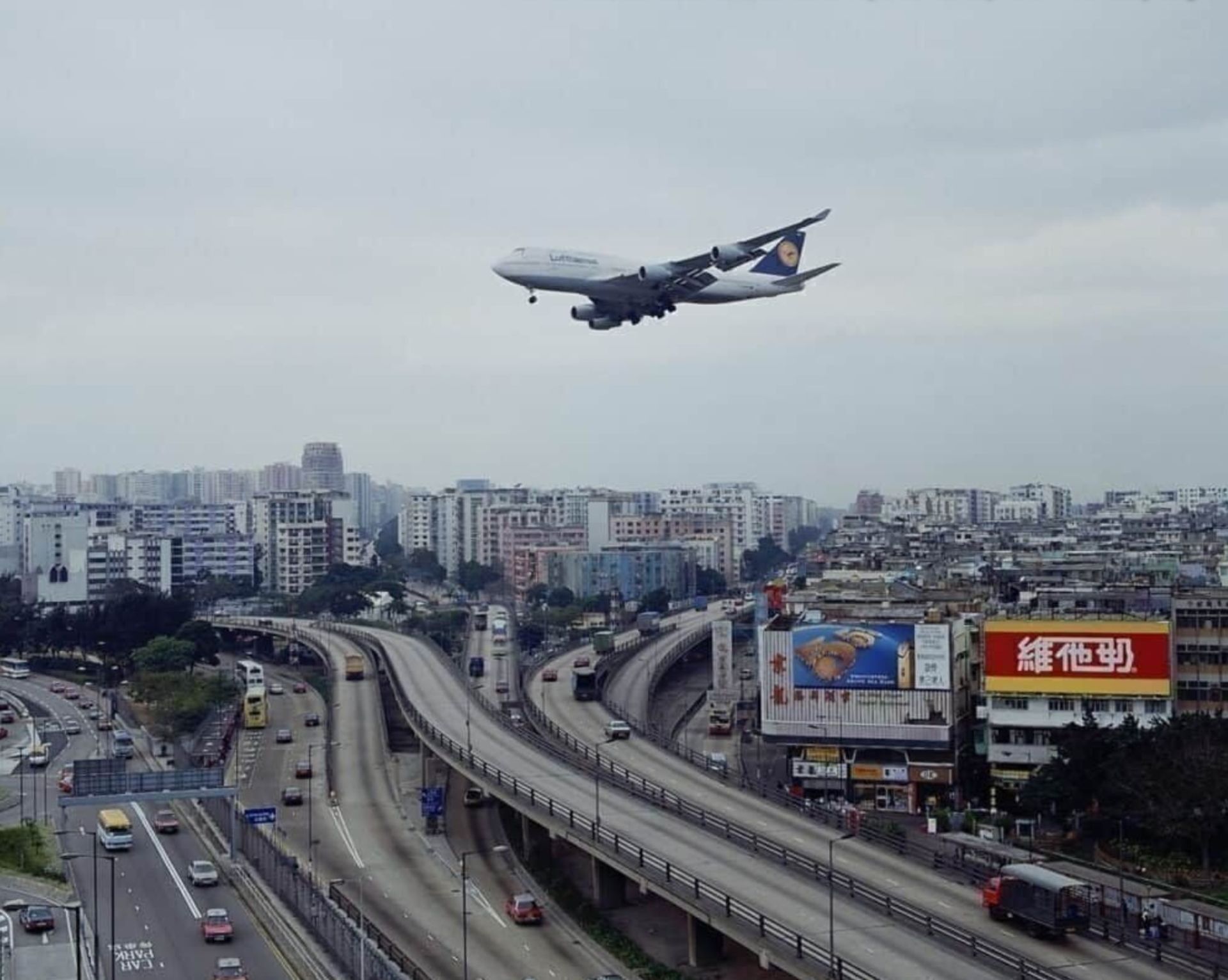
The place to build the artificial island of this airport was chosen in the 1980s. According to the chosen location, it is possible to develop this airport like the Kansai airport, and due to its distance from urban areas, it was possible to carry out 24-hour construction operations and of course to operate it. The materials needed to build the artificial island and rehabilitate the airport land with an area of 12.4 square kilometers were provided by two local islands. According to the Hong Kong airport authorities, the airport’s land reclamation operation added 1 percent to the total area of Hong Kong!
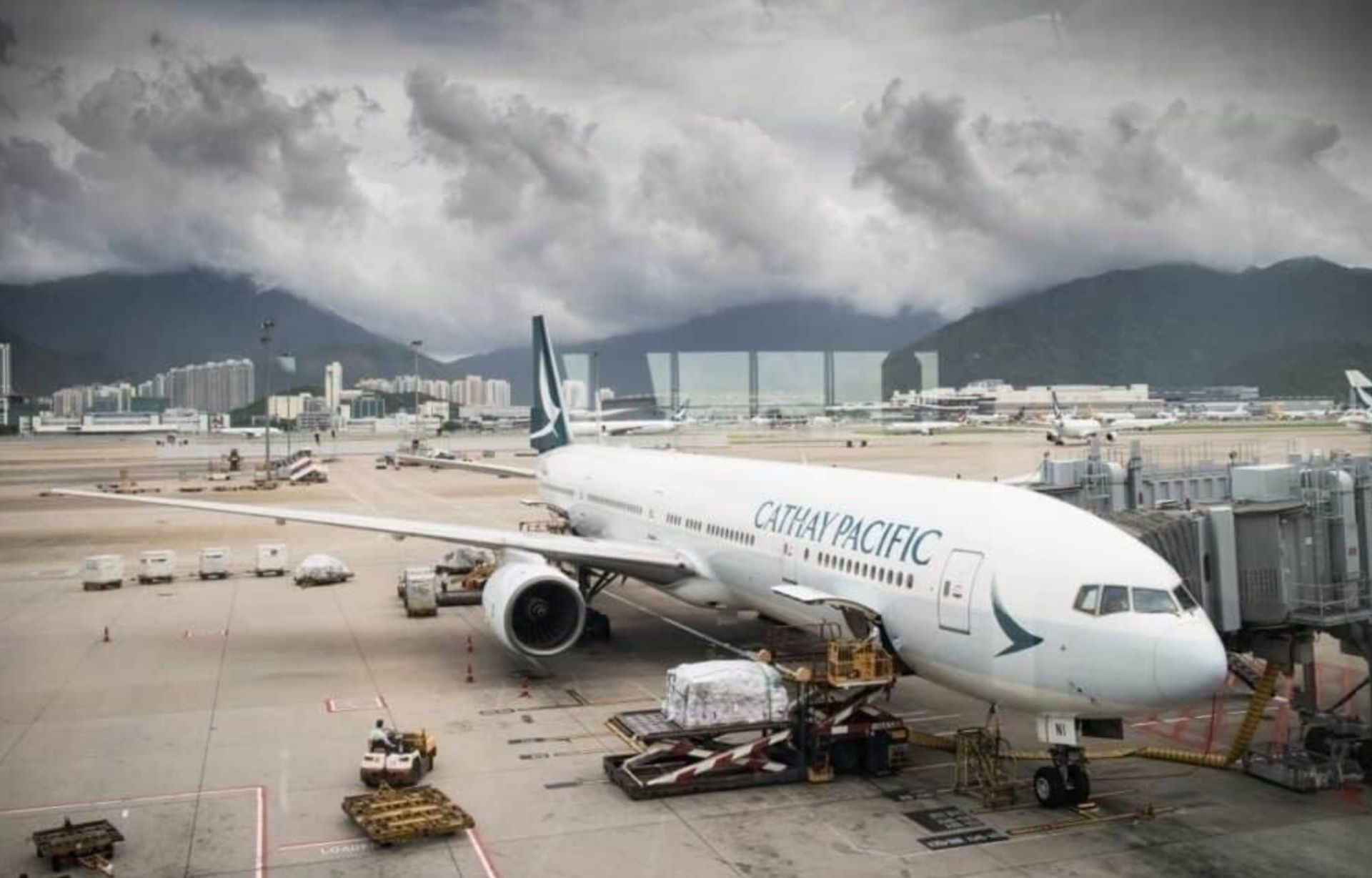
Like Osaka Kansai Airport, the possibility of implementing development projects for Hong Kong Airport is also foreseen. There are currently plans to build a third runway by reclaiming more land in the northern part of the airport.
Kobe Airport
The city of Kobe, which had not used the opportunity to host Kansai Airport before, started operating its island airport in 2006. Plans to build a special airport for Kobe gained momentum when an earthquake near the city highlighted the need for critical infrastructure such as an airport to help the region’s economic redevelopment.
Kobe Airport is built with a landing strip near the coast of this city and on an artificial island. This airport is much smaller than its counterpart in Kanzai city and is dedicated only to domestic flights and some regional flights.

Nagoya Chubu Centrair International Airport
Nagoya Centrair Airport is the second airport in Japan that was built on an artificial island. Of course, it should be mentioned that Nagasaki Airport was built before Chobu Centrair, but its construction was done on an island that was revived and used in another project before that.
The construction of Nagoya Chobu Island and Airport started in 2000 and ended in 2005. This airport is used by the people of Nagoya and its suburbs. It should be noted that this area is the third largest metropolitan area in Japan after Tokyo and Osaka. Here, too, the purpose of building an airport on an island was to stay away from dense urban areas and enable its 24-hour operation. Of course, one of the other motivations for the construction of Chubu Centrair Airport in this place is the presence of heavy industries such as Toyota and Mitsubishi in this area.
Malé Airport in the Maldives
Japan is not the only country that builds its airports on the island. The country of Maldives is also very eager to do this and the reason is simple; There is not enough space to build an airport in this country.
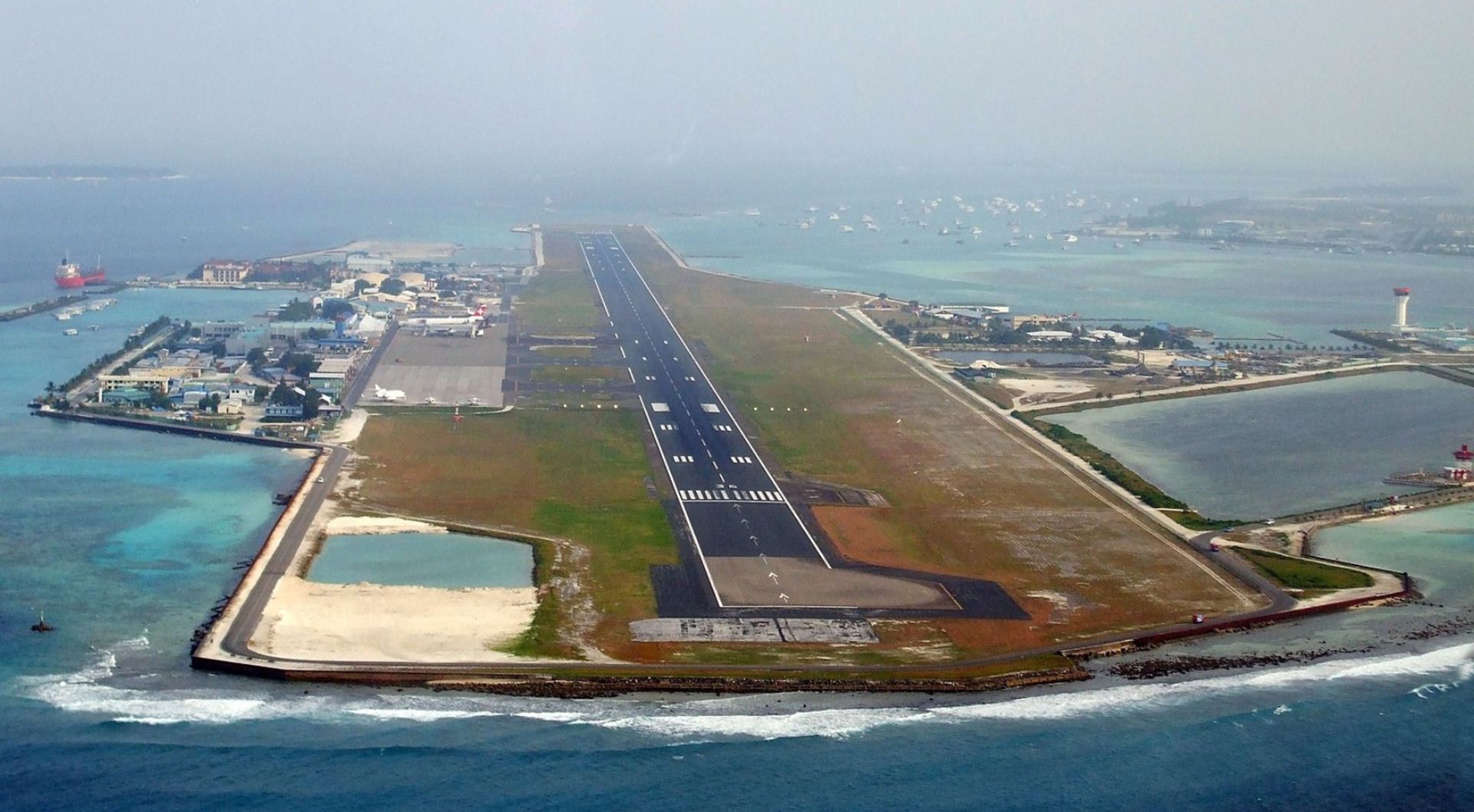
The main airport of the Maldives, Male International Airport, is built on the island of Helhola. Halholah is not an artificial or restored island, but rather a coral island or atoll. This airport has a 3.2 km runway and is only 2 meters above the water level.
What do you think about airport island structures around the world?


You may like
Technology
Unveiling of OpenAI new artificial intelligence capabilities
Published
6 hours agoon
14/05/2024

OpenAI claims that its free GPT-4o model can talk, laugh, sing, and see like a human. The company is also releasing a desktop version of ChatGPT’s large language model.
Unveiling of OpenAI new artificial intelligence capabilities


Natural human-computer interaction
What exactly does the introduction of this model mean for users?
Strong market for generative artificial intelligence




Samsung S95B OLED TV review
What can be placed in a container with a depth of 4 mm? For example, 40 sheets of paper or 5 bank cards; But to think that Samsung has successfully packed a large 4K OLED panel into a depth of less than 4mm that can produce more than 2000 nits of brightness is amazing. Join me as I review the Samsung S95B TV.
Samsung has a very active presence in the smartphone OLED display market, and by the way, it also has some of the best and most stunning small OLED panels in its repertoire; But surprisingly, it has been a little more than a year since he seriously entered the OLED TV market; Of course, Samsung launched its first OLED TV in 2013 and quickly withdrew from the large-size OLED market and left the field to its traditional and long-standing rival, LG.
In the years after withdrawing from the OLED TV market, Samsung focused on the evolution of LCD TVs with technologies such as Quantum Dot and MiniLED; But after almost 10 years, Samsung decided to once again try its luck in the world of OLEDs, and thus, in 2022, it launched the S95B TV in two 55-inch and 65-inch models.
In 2023, Samsung introduced the S95C TV as a successor to the S95B and unveiled the S95D model at CES 2024; While Samsung’s 2024 TV has just been launched in international markets a few months after its launch, it is still hard to find its 2023 model in the Iranian market. Accordingly, we have prepared the 65-inch S95B model from 2022 for review. It is more numerous than the 2023 model in the market of the country.
Slim design… super slim
What draws attention to Samsung TV at first sight is not its eye-catching image and ear-pleasing sound, but its infinite slimness. The S95B was so slim that when I unboxed and installed it, I experienced the same level of anxiety I had on exam night! Samsung OLED TV is only 3.89 mm thick; For this reason, despite all the company’s efforts in strengthening the body, it still simply shakes and sways.

Samsung calls the ultra-slim design of its TV LaserSlim; Because the laser beam is narrow and sharp; So you should be very careful when installing the TV. I wish we knew what is the logic behind the childish efforts of companies to make the world’s thinnest TV. To some extent, the narrowness of the TV helps to make it more modern and better installed on the wall; But the strength of the TV should not be sacrificed to make it thinner.

Samsung designers have not spared even the edges of the TV! The width of the edges around the panel does not exceed 8 mm. The narrowness of the edges helps the user to immerse well in the depth of black and the extraordinary contrast of the OLED TV panel and enjoy the content to the fullest.

The S95B TV has a high-quality and well-made body, the frame of the device is metal, and like most OLED TVs in the market, there is a wide plastic protrusion in the lower half of which parts such as the board, speakers, and power supply are placed. Due to this protrusion, the thickness of the body reaches 4.1 cm in the maximum state.




Unfortunately, just like LG’s OLED TVs, the base of the S95B is also located in the middle of the device; Although the base itself is metal and relatively wide; the large dimensions of the TV and its very small thickness make it not to be firmly and firmly placed on the table and not to wobble; Of course, you can install the TV on the wall with a 300×200 mm VESA mount.


All the ports of the S95B TV, including HDMI and USB, are included in the plastic protrusion on the back of the device. These ports are covered with a plastic screen to integrate and beautify the back of the device. After installing it, surprisingly, you won’t be able to access the ports! Samsung TV ports are as follows:
- Four HDMI 2.1 ports with the ability to transfer 4K120 image signal; Two ports facing down and two ports on the side of the frame
- Two USB 2.0 ports on the side of the frame
- A network port
- Internal and external receiver input
- An optical audio output
One of the HDMI ports (number 3) has eARC capability and can be used to connect the device to the soundbar. USB ports are also different in terms of current and voltage; One of the ports is limited to 0.5 amps and 5 volts and the other is limited to 1.0 amps and 5 volts; Therefore, it is considered a more reasonable option for connecting an external hard drive.
Stunning brightness and disappointing color accuracy
I mentioned earlier that we had the 65-inch S95B model available for review. With such dimensions, you can enjoy the 4K resolution of the panel the most if you sit at a distance of about 2 meters from the TV; At closer distances, pixels can be separated, and at distances greater than 2 meters, your brain’s perception of a 4K image will be no different from a 1080p image.

The Samsung S95B TV uses a 10-bit OLED panel with a resolution of 4K or 2160 x 3840 pixels and can display more than a billion colors. Supporting this number of colors is essential to provide an optimal experience of HDR content playback. In the following, I will explain more about the compatibility of Samsung TVs with HDR standards and the quality of color display.
Unlike LCD panels, where the light needed by the pixels is provided by a number of LED lights on the edge or back of the panel, in OLED panels, each pixel provides its own light; As if instead of a limited number of exposure areas, for example 500-600 in MiniLED TVs, we have more than 8 million exposure areas; Thus, to display the color black, the pixels are turned off, so that instead of a spectrum of gray color, we see a deep black and experience an extremely high contrast.
 The absence of any Blooming thanks to the precise control of light in the TV’s OLED panel
The absence of any Blooming thanks to the precise control of light in the TV’s OLED panel
The great advantage of self-lit pixels (pixels that provide their own light) in displaying deep black and preventing the Blooming phenomenon (creating a halo around bright subjects in a dark background) thanks to the very precise control of the light distribution, also has some weaknesses; The greater vulnerability to burn-in phenomenon during long-term static image display and the lower level of OLED panel brightness compared to MiniLED samples are among these weaknesses.
Like other OLED TVs, the S95B TV is not immune to the risk of burn-in. In order to reduce the possibility of this phenomenon, the Koreans have considered solutions such as moving the image slightly in different time periods. Unfortunately, we do not have the possibility to examine the TVs for a long time to evaluate their performance in preventing the risk of burn-in; But at least based on RTINGS’ long-term and unrealistic test, the S95B seems to be more vulnerable compared to its competitors; However, in real use, it is unlikely that a user would want to watch TV with such intensity.
To overcome the inherent weakness of OLED panels in achieving higher levels of brightness, Samsung engineers have combined quantum dot technology with OLED panels. Quantum dots are very small crystal particles that are layered in the heart of the display panel. With the help of the quantum dot layer, the panels achieve higher brightness and produce more vivid colors. Samsung calls its combined panel QD-OLED and claims that with the help of the Neural Quantum processor in the heart of the S95B TV, this panel can raise the brightness to a higher level than its competitors.
|
Samsung S95B 65-inch TV brightness with default settings |
||||
|---|---|---|---|---|
|
Image modes/pattern white percentage |
10 percent |
50 percent |
100 percent |
|
|
SDR |
Dynamic |
1065 |
633 |
364 |
|
Standard |
740 |
487 |
281 |
|
|
Movie |
430 |
399 |
229 |
|
|
HDR |
Dynamic |
2094 |
— |
— |
|
Standard |
2179 |
— |
— |
|
|
Movie |
2179 |
— |
— |
|
|
FILMMAKER Mode |
2175 |
— |
— |
|
In my measurements, when only 10% of the screen was lit and the device was playing a normal SDR image, the brightness of the S95B panel reached 1100 nits in the highest mode, which is a very good number and better than the brightness of the C2 and C3 TVs in the same conditions, respectively. It is about 300 and 100 nits more.
Aside from the S95B’s excellent performance in SDR image brightness, the real magic happens when the device is playing HDR video. In this situation, when 10% of the screen is lit, the brightness reaches a stunning number of about 2200 nits, which is 700 nits more than the HDR brightness of the C2 and C3 TVs. Achieving such a level of brightness helps the TV to deliver a stunning HDR movie viewing experience.
|
Comparison of brightness and contrast of S95B with other TVs |
||
|---|---|---|
|
TV/parameter (the brightest profile) |
Brightness (50% pattern) |
contrast |
|
Samsung S95B |
633 |
∞ |
|
LG C3 |
603 |
∞ |
|
LG QNED80 |
580 |
116 |
|
LG NANO84 |
295 |
149 |
|
LG C2 |
525 |
∞ |
|
LG QNED96 |
470 |
— |
Note that the stunning numbers of 1100 and 2200 nits are obtained when a small part of the screen is bright, which is often the case in movies and series, and the entire image is not full of bright colors; But when the whole screen is lit; For example, consider a scene from The Lord of the Rings where we see Galadriel in the land of the elves, in such a situation, the maximum brightness of the whole screen is about 370 nits, which is still 40 nits higher than the LG TV.

Thanks to the panel’s excellent brightness and the deep blacks produced by the muted pixels, it’s no surprise that the Samsung TV’s image contrast is superb; Especially since there is an anti-reflective coating on the panel so that you can enjoy the image even in bright environments; Note that unlike what comes from the corners of the panel, you should not remove this anti-reflective layer from the panel; Otherwise, you will face problems like us!
If you think that the S95B is the best TV on the market so far, I must say that not everything about the S95B is rosy.
The S95B TV provides the user with the following four color profiles, all of which tend to be very cold by default and do not produce very accurate colors.
- Dynamic
- Movie
- Standard
- FILMMAKER Mode
Like most OLED TVs on the market, the S95B TV also covers a wide range of colors. In my tests, the Samsung TV managed to cover about 148% of the sRGB color space, nearly 100% of the DCI P3 wide space, and 75% of the Rec 2020 ultra-wide space. These numbers are great, But the disappointing thing is the very low accuracy of the device in producing the mentioned colors with factory settings.
|
Samsung S95B 65-inch TV performance in covering color spaces with default settings |
||||||
|---|---|---|---|---|---|---|
|
Image mode/color space |
sRGB |
DCI-P3 |
Rec. 2020 |
|||
|
cover |
mean error |
cover |
mean error |
cover |
mean error |
|
|
Dynamic |
146 |
— |
98.6 |
13.7 |
77.9 |
— |
|
Standard |
147.7 |
— |
99.7 |
12.1 |
78.7 |
— |
|
Movie |
125.4 |
— |
89.5 |
4.6 |
65.5 |
— |
|
FILMMAKER Mode |
121.9 |
— |
89.5 |
4.1 |
64.6 |
— |
Note that the FILMMAKER mode belongs to the UHD union and most big companies like Samsung, LG and Hisense use it in their TVs. On paper, with FILMMAKER mode, we should see movies as the director intended.
|
Comparison of Samsung S95B color accuracy with other TVs (default settings) |
||
|---|---|---|
|
TV/parameter (the most accurate profile) |
DCI P3 |
|
|
Covering |
Color accuracy |
|
|
Samsung S95B |
89.5 |
4.1 |
|
LG C3 |
96.8 |
3.0 |
|
LG QNED80 |
90.7 |
2.7 |
|
LG NANO84 |
82.9 |
— |
|
LG C2 |
98.7 |
2.1 |
|
LG QNED96 |
90.8 |
3.9 |
The most accurate colors of the S95B TV are depicted by the FILMMAKER Mode profile with an error of 4.1, in which the TV covers about 90% of the DCI P3 color space; As a comparison, in the review of the C3 TV, the color display error in the same FILMMAKER mode was 3.6 and in the most accurate color profile it was 3.0; Therefore, Samsung TV does not have an interesting performance in terms of factory calibration of colors.
We were so surprised by the results that we returned the TV and got another S95B to review, But the results did not change.
Fortunately, Samsung TV provides you with various settings to change parameters such as gamma, color temperature, color hue, and brightness limiter (ABL) so that you can achieve your desired style and style for displaying colors; For example, I was able to reduce the color display error in the Standard profile from a terrible number of 12.1 to a very good number of 3.0 by making the following changes.
|
Color accuracy of S95B TV after minor changes in panel settings |
|||
|---|---|---|---|
|
Image mode/color space |
DCI-P3 |
||
|
Settings |
Average error (recommended: less than 3) |
Color temperature (neutral: 6500 K) |
|
|
Standard |
default settings |
12.1 |
14236 |
|
ABL: Off Contrast Enhancer: Low Gamma: 2.2 |
3.0 |
8180 |
|
Another weakness of Samsung S95B TV compared to LG OLEDs is that it does not support HDR videos with Dolby Vision standard; The iPhone, for example, records HDR video using the same standard. Samsung TV supports HDR10, HDR10+, and HLG standards.

Like other OLED TVs, the Samsung S95B TV has wide viewing angles, and even from the corners, it displays colors with the least drop in freshness; So if you use wide furniture at home, you can safely go to S95B.
Samsung has focused a lot on the gaming capabilities of its TV; The device uses a 120 Hz panel with support for FreeSync Premium and G-Sync technologies, and the TV itself provides the user with Game Mode, which, by activating it, significantly reduces Input Lag, makes available a variable refresh rate, and The frames of the games can also be seen.

Samsung compensates for the visual weaknesses of the S95B TV with the amazing listening experience of its powerful speakers; While a TV like the LG C3 uses 40-watt speakers, Samsung engineers have used 60-watt speakers with a 2.2.2 channel combination in the S95B’s slim body; In the sense that two speakers throw the sound down, two speakers throw the sound up, and two woofers are responsible for producing low frequencies.
The S95B TV supports Dolby Atmos surround sound and its sound output is considered excellent for a TV; The volume is high, you can hear the pounding bass, and at high volumes, the distortion is controlled at a reasonable level.
Tizen; The user interface is more limited and different from competitors
Finally, we must avoid the TV user interface; Samsung’s OLED TV, like the rest of the company’s TVs, uses the Tizen operating system. The user interface of the device is smooth and smooth, moving between different menus of the user interface is done without problems, although sometimes with a little slowness; But the device can play most of the video formats.




A number of functions are also available, which doubles the enjoyment of the TV experience, provided that the user uses a Samsung phone; For example, you can run the Samsung phone’s desktop mode or Dex on the TV and use the phone’s screen as a trackpad. The phone can even be used as a webcam to make video calls with Google Mate on the TV.
If you want to write a text, you can call Microsoft365 from the Workspace section of the user interface by connecting a Bluetooth mouse and keyboard to the Samsung TV and start writing in Microsoft Word software.

Samsung Internet Browser is available in the S95B TV user interface; But the Samsung remote control, despite its compact design and the possibility of being charged with a solar panel or USB-C port, does not have the ability to use a mouse; So you have to browse the web with the arrow keys of the remote control; In my opinion, this is one of the main weaknesses of Samsung TV compared to LG TV with its practical magic remote.



As another weakness, we should mention Samsung’s not very rich store; For example, you can’t find some useful apps like Spotify or native apps like Filmo in the Samsung TV store.
Read more: How to connect to the TV with a Samsung phone?
Without a doubt, the S95B is one of the most stunning TVs we’ve ever reviewed on Zoomit; An attractive and extremely slim device that will amaze you with its stunning brightness and contrast, impressive gaming capabilities, and very powerful speakers.
In terms of factory color calibration, the S95B appears below expectations and a bit disappointing; So, if you are not very fond of the image and do not know much about color parameters, you will have to start with inaccurate and very cold colors; But if you are aware of the color parameters, you can change them and enjoy the attractive picture of the TV to the fullest.

The S95B TV is one of Samsung’s 2022 flagships, and now its 65-inch model is sold in the price range of 105 million Tomans; In this range, go for the more updated LG C3 TV with more accurate colors, or for a little more money, choose the Sony A80L TV for 2023, which is powered by a more practical Android operating system; In addition, C2 TV is also available at a price of 10 million less than in 2022.
what is your opinion? Do you think the S95B is a reasonable choice or do you prefer other models from LG or Sony?
Pros
- Very high brightness
- 6 powerful speakers
- Very modern and attractive design
- Deep black and excellent contrast
Cons
- Low color accuracy with default settings
- Too thin and vulnerable body
Technology
MacBook Air M3 review; Lovely, powerful and economical
Published
1 week agoon
06/05/2024

MacBook Air M3 review; Lovely, powerful and economical
If you are looking for a compact, well-made and high-quality laptop that can be used in daily and light use, the MacBook Air M3 review is not for you; So close the preceding article, visit the Zomit products section and choose one of the stores to buy MacBook Air M1 ; But if you, like me, are excited to read about the developments in the world of hardware and are curious to know about the performance of the M3 chip in the Dell MacBook Air 2024 , then stay with Zoomit.
The design is a copy of the original from the last generation
Almost two years have passed since Apple said goodbye to the familiar and wedge-shaped MacBook Air design; A different design that accompanied this ultrabook from the first day of its birth in 2008; But finally in 2022, with the aim of harmonizing the design language of the Apple laptop family, it was abandoned so that the MacBook Air 2022 will have a similar appearance to the 14-inch and 16-inch MacBook Pro.
The new MacBook Air is uniform in thickness; But it was slimmer, the screen was bigger, the edges were narrower and the corners were rounded, and a relatively large notch was added to it, whose only existence was to host the device’s 1080p webcam. MacBook Air 2022 also marked the return of the MagSafe magnetic charging port to Apple’s popular Ultrabook.

Previously, in the review of the MacBook Air 2022 with the M2 chip, we have talked comprehensively and deeply about its design and its positive and negative points. I suggest that if you haven’t read the article, you must visit it; Because the MacBook Air M3 is no different from the MacBook Air M2 in terms of appearance, display, or ports.
We also see the same incredibly well-made and metal body of MacBook Air 2022 in the new generation of Apple Ultrabooks; A body that, like the rest of Apple laptops, is carved from an aluminum block instead of the usual method of using aluminum sheets, and for this reason, it has a strong and dense structure so that we do not see the body sinking when pressing the keyboard area or the screen frame swinging.



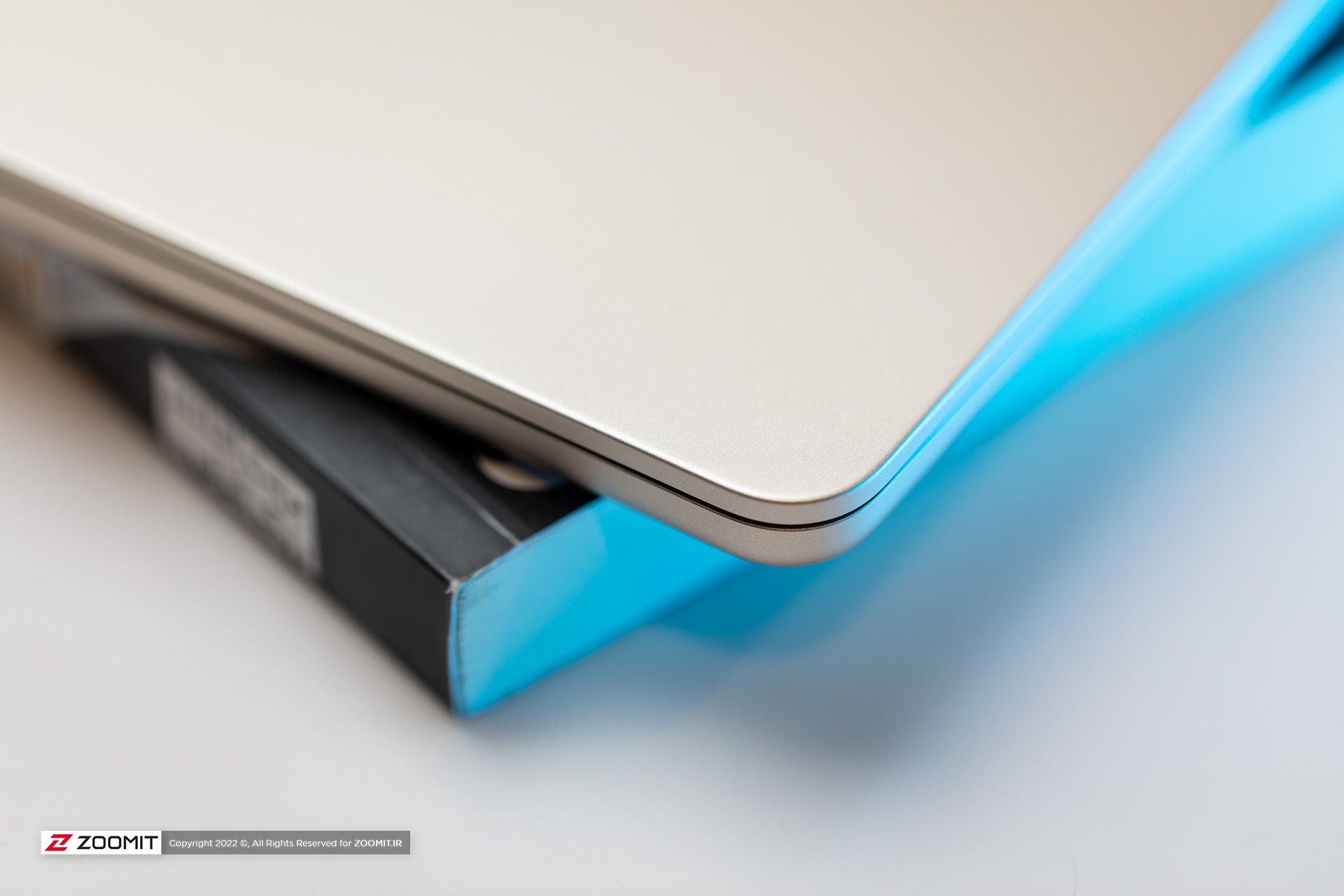
All the parts of the MacBook Air 2024 are assembled with the utmost care; So that there is no gap between them. As expected, the hinge of the laptop is also well-adjusted so that you don’t need to use two hands to open the laptop door. All in all, the combination of the quality of components and Apple’s exemplary engineering precision, brings an extremely enjoyable and unique feeling to the user while using the MacBook Air.
Just like the previous generation, the new MacBook Air is sold in four colors: gray, silver, dark blue, and cream. One of the flaws that could be found in the design of the MacBook Air 2022 was that fingerprints and grease remained on the body; The item that was more noticeable in dark blue color. Apple says this year it has used a new coating that reduces the severity of this problem. We did not have the 2022 model available for comparison at the time of writing the following review, But traces of fat and finger still remain on the body of the MacBook Air 2024.
 Grease and fingerprints on the laptop body
Grease and fingerprints on the laptop body
MacBook Air keyboard is among the best examples in the market in terms of arrangement and dimensions, feedback, and key stability; But the matte coating on the keys absorbs the fat of the fingers very quickly, and on the other hand, like other MacBooks, there is a possibility that the matte coating will disappear and the keys will become shiny. Depending on your usage, this can happen very quickly or over time; For example, for me, who is constantly writing, the keys on my MacBook Pro M1 burned out in less than a year.
Apparently, the buyers of used laptops are very sensitive about the keys being electrocuted; Therefore, if you plan to replace your Macbook with another laptop after one or two years, be sure to keep this in mind and use an external keyboard for long typing.
As always, the trackpad is one of the main strengths of any MacBook, and the MacBook Air M3 follows the same rule. The glass trackpad of the device is large in size and has little friction on its surface, it offers flawless, accurate, and smooth performance, and its Fortouch mechanism, which makes it possible to click on the entire surface of the trackpad, is so efficient that after the MacBook, it is impossible to work with the trackpad of any laptop. Another enjoyed.
 MacBook Air 2022
MacBook Air 2022
The set of MacBook Air 2024 ports is limited and has not changed; On the right side of the device, there is a headphone jack, and the left side of the device hosts two USB4 ports and a MagSafe magnetic charging port. Along with the basic model, Apple provides a relatively small 30-watt adapter with a cloth cable of the same color as the device’s body; But you can also get the laptop with a more powerful 35 or 70-watt adapter, which charges the battery up to 50% within half an hour.
USB4 ports support Thunderbolt 3 standard with a bandwidth of 40 Gbps, But it is not possible to connect external graphics. Both ports also transmit the image signal with the DisplayPort standard. In the new MacBook, if you close the laptop door, you can connect a 6K monitor and a 5K monitor (both 60Hz) to the device at the same time; But with the laptop’s screen on, just like the MacBook Air M2, the image output is limited to a 6K monitor; It is interesting that the Intel version of MacBook Air could output images to two 4K monitors at the same time as its own screen is on!
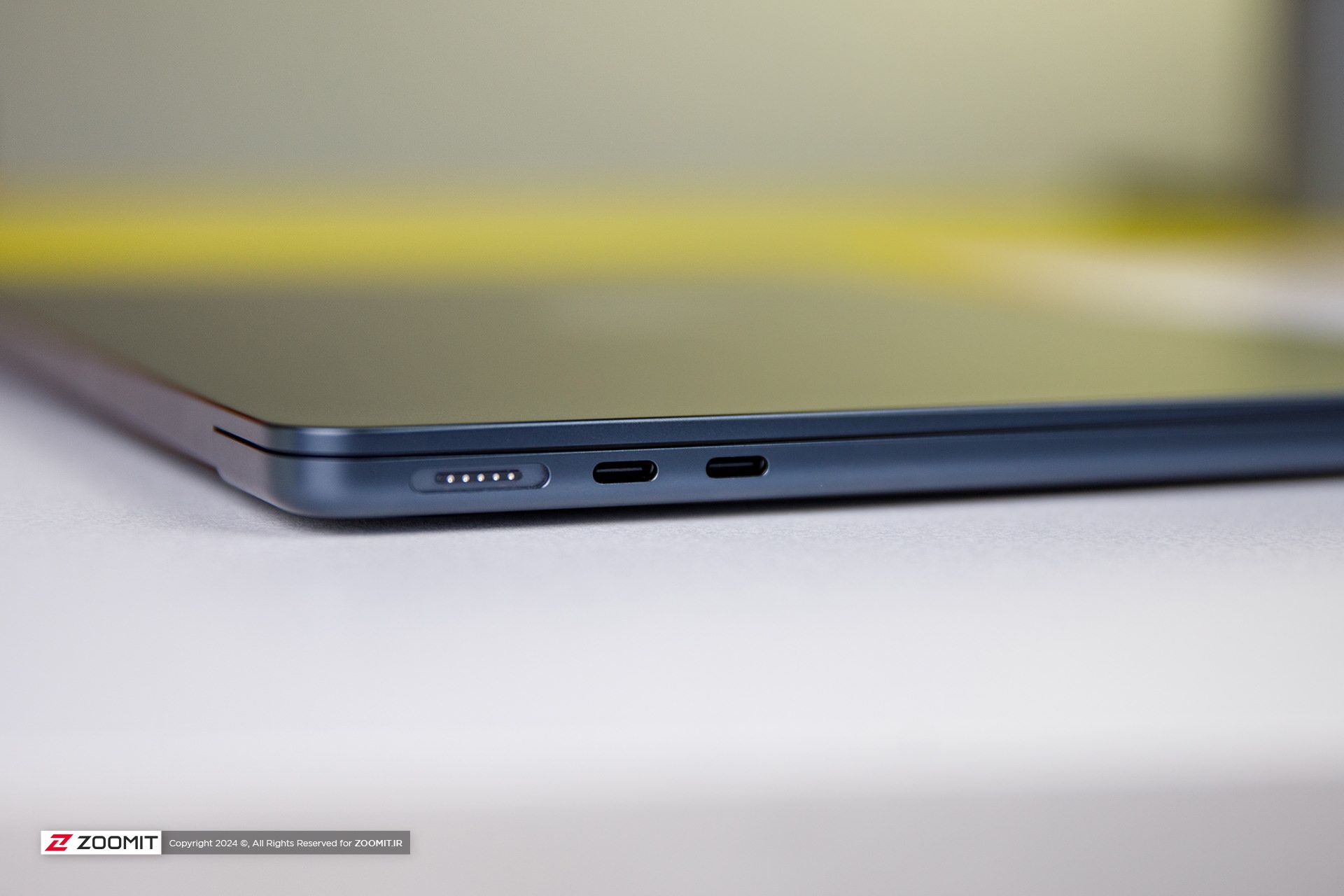

As in the previous generation, Apple uses Bluetooth version 5.3 in its Ultrabook; But the Wi-Fi module has upgraded the device from Wi-Fi 6 to Wi-Fi 6E, which incompatible networks can increase the communication bandwidth of MacBook Air 2024 with the router and the rest of the devices in the network from 1.2 to 2.4 Gbps.
Attractive display with more attractive competitors
Like most parts of the device, the screen of the new MacBook Air does not change; Of course, in this field, you can’t criticize Apple much, since 2018, when the MacBook Air screen became Retina, it has always been among the best; However, today, with OLED competitors with stunning colors and infinite contrast, Apple’s Retina display no longer has its former glory.
MacBook Air M3 can be purchased just like the previous generation in two 13.6-inch and 15.3-inch models. The pixel density of both versions is a very good number of 224 pixels. With this density, the MacBook Air screen produces a very clear image. So that it is difficult to distinguish the pixels from each other. We have the 13.6-inch MacBook Air M3 with a resolution of 2560 x 1664 pixels available for review.

Unfortunately, unlike the expensive models of MacBook Pro or even Windows Ultrabooks with the same price as Zenbook, the panel of the MacBook Air is 60 Hz and it does not have amazing technologies such as OLED and MiniLED to produce 1000 nits of brightness and extraordinary colors. MacBook Air uses an 8-bit IPS LCD panel with back exposure, which, by using FRC technology, can give the user the feeling of 10-bit panels with a billion colors.
MacBook Air covers the wide DCI P3 color space with high accuracy. The Apple Ultrabook covers 98.4% of this space with an error of 1.9 (an error of less than 3 is ideal), perhaps the only color weakness of the panel can be considered a slight tendency to be cold; However, thanks to the True Tone feature, the device evaluates the ambient light temperature with high accuracy and adjusts the color temperature accordingly to give you a satisfying visual experience.
In our measurements, with a 50% raster standard, we reached a maximum brightness of 443 nits, which in itself is a very good number, and thanks to the anti-reflective coating on the panel surface, in environments with different light conditions, it brings a satisfactory experience of working with a laptop. Without the appearance of the shadow of the environment on the panel, the user will not be bothered.
|
MacBook Air 2024 screen performance against other laptops |
||||||||||
|---|---|---|---|---|---|---|---|---|---|---|
|
Laptop / test |
White image |
Black image |
contrast ratio |
AdobeRGB |
sRGB |
DCI-P3 |
||||
|
Maximum brightness |
Minimum brightness |
Average brightness |
Native |
cover |
Average error |
cover |
Average error |
cover |
Average error |
|
|
MacBook Air 2024 |
443 intentions |
0.00 nits |
0.67 nits |
661 |
87.9 |
— |
100 |
2.4 |
98.4 |
1.9 |
|
Zenbook 14 |
512 intention (788 nits HDR) |
0.27 nits |
0 intentions |
∞ |
89.6 |
2.6 |
100 |
0.6 |
99.7 |
1.3 |
|
MacBook Pro 2022 |
437 intentions |
0.00 nits |
0.5 nits |
874 |
86.3 |
— |
99.8 |
2.7 |
97.5 |
— |
|
MacBook Air 2022 |
447 intentions |
0.1 nit |
0.65 nits |
693 |
87.5 |
— |
100 |
2.5 |
98.1 |
— |
|
Galaxy Book 3 Ultra |
441 intentions |
4 intentions |
0 intentions |
∞ |
97.3 |
3.7 |
99.6 |
1.9 |
99.8 |
2.3 |
|
MacBook Pro M1 Max |
455 intentions (1497 nits HDR) |
0 intentions |
0 intentions |
∞ |
85 |
— |
121.6 |
— |
97.3 |
2.5 |
In addition to the reasonable maximum brightness of 442 nits in bright images, unlike most laptops with IPS LCD screens, the black color brightness is also very low in the MacBook Air display; So that the device achieves a very high contrast. On the other hand, the minimum brightness of the display was 0 nits even with the 0.01 nits accuracy of the Zoomit luminance meter; In the sense that while using the laptop, there will be a little pressure on your eyes.
The attractive screen of the MacBook Air is completed by a set of 4 speakers; Speakers that have a very large sound volume compared to the size of a laptop, produce clear sound, and at high volumes, they are confused and distorted. MacBook Air speakers support Dolby Atmos and are easily ahead of most Windows laptops.
M3 chip and championship called TSMC
The main changes of MacBook Air 2024 have happened in its heart; Where it hosts the M3 chip as the beating heart of the device. Next, before we put the performance of the M3 under the microscope, we take a look at the details of the technical specifications of this chip.
The M3 chip is manufactured using TSMC’s 3nm-based manufacturing process known as N3B, hosts 25 billion transistors on its surface, and uses the same layout and configuration as the M2 for the CPU and GPU cores. Apple says the processor and graphics used in the M3 are about 35 and 65 percent faster than the M1, respectively.
|
Technical specifications of M3 against M2 and M1 |
|||
|---|---|---|---|
|
parameters/chip |
Apple M3 |
Apple M2 |
Apple M1 |
|
manufacturing process |
3 nanometer N3B TSMC |
TSMC’s second-generation 5nm |
5 nm N5 TSMC |
|
CPU |
4 powerful cores with a maximum frequency of 4.05 GHz 4 low-power cores with a maximum frequency of 2.75 GHz |
4 Avalanche cores with a maximum frequency of 3.5 GHz 4 Blizzard cores with a maximum frequency of 2.4 GHz |
4 Firestorm cores with a maximum frequency of 3.2 GHz 4 Icestorm cores with a maximum frequency of 2.0 GHz |
|
cache memory |
16 MB shared L2 cache and 320 KB L1 cache for each of the powerful cores 4 megabytes of shared L2 cache and 192 kilobytes of L1 cache for each low-power core 8 MB system cache for the entire chip |
16 MB shared L2 cache and 320 KB L1 cache for each of the powerful cores 4 megabytes of shared L2 cache and 192 kilobytes of L1 cache for each low-power core 8 MB system cache for the entire chip |
12MB shared L2 cache and 320KB L1 cache for each Firestorm core 4 MB shared L2 cache and 192 KB L1 cache for each Icestorm core 8 MB system cache for the entire chip |
|
memory bass |
128 bits |
128 bits |
128 bits |
|
DRAM |
8 to 24 GB LPDDR5-6400 |
8 to 24 GB LPDDR5-6400 |
8 or 16 GB LPDDR4x-4266 |
|
Memory bandwidth |
100 GB per second |
100 GB per second |
68.2 gigabytes per second |
|
GPU |
8 or 10 cores with hardware support of ray tracing |
8 or 10 cores |
7 or 8 cores |
Like the last two generations, the M3 chip uses a combination of 4 high-power cores and 4 low-power cores, respectively, with maximum frequencies of 4.05 and 2.75 GHz as CPU. Apple has made minor changes in the architecture of the cores, and the main difference of the cores is the 15% increase in frequency compared to the M2 cores.
Apple has not even changed the amount of cache memory of the M3 chip compared to the M2; Each of the high-power and low-power cores have access to 320 and 192 KB of ultra-fast L1 cache, respectively, the set of four high-power and low-power cores also have access to 16 and 4 MB of L2 cache, respectively, while the system cache is 8 MB for the set of chip processing blocks. GPU and CPU are included.

The M3 chip is used in Apple laptops in two versions with 8- and 10-core graphics processors. We had the MacBook Air with 8-core graphics available for review, which in total, just like the last generation, has 128 execution units with 1024 calculation and logic units in its heart, which operate at an almost identical frequency of 1.38 GHz.
The main difference between the M3 graphics compared to the previous generation is the addition of the Ray Tracing hardware accelerator, Mesh shading, and Dynamic Caching technology, the latter of which allows the chip to provide the memory required by the GPU in real-time and based on the type of processing. Thus, it optimizes the amount of memory consumption.
The M3 chip uses a 16-core neural processing unit (NPU) with a computing power of 18 trillion operations per second, and in addition to ProRes and ProRes Raw videos, it now has a separate engine for AV1 video codec decoding. Due to its two 64-bit channels and support for LPDDR5X-6400 RAM, this chip can achieve a bandwidth of 102 GB/s for data exchange with its integrated RAM.
|
Performance of the MacBook Air M3 in benchmarks while plugged in |
||||||
|---|---|---|---|---|---|---|
|
Laptop/benchmark |
Technical Specifications |
Web browsing |
Performance in graphics |
CPU performance in rendering |
CPU computing power |
GPU computing power |
|
3 Dark |
CineBench R23 |
GeekBench 6 |
GeekBench 6 |
|||
|
Speedometer 2.1 |
TimeSpy |
Single Multi |
Single Multi |
OpenCL Metal/Vulkan |
||
|
DirectX 12 |
||||||
|
MacBook Air 2024 |
Apple M3 8 core GPU |
680 |
— |
1897 9872 |
3143 2008 |
25845 41671 |
|
Zenbook 14 |
Core Ultra 7 155H Intel Arc GPU |
396 |
3453 |
1637 13367 |
2290 12256 |
34889 38268 |
|
MacBook Pro 2022 |
Apple M2 10-core GPU |
407 |
— |
1579 8730 |
2581 9641 |
28852 42673 |
|
MacBook Air 2022 |
Apple M2 8 core GPU |
405 |
— |
1577 8476 |
2578 9655 |
27846 39735 |
|
MacBook Pro 2020 |
Apple M1 8 core GPU |
209 |
— |
1512 7778 |
2335 8315 |
21646 32743 |
|
MacBook Pro 14-inch 2021 |
M1 Max 24Core GPU |
300 |
— |
1549 12508 |
2378 12239 |
65432 101045 |
MacBook M3 appears about 20-25% faster than M2 in single-core and multi-core benchmarks, and in comparison with M1, it increases its superiority to about 35-45%; Therefore, considering the 15% increase in frequency and the improvement of TSMC’s manufacturing process, it seems that Apple has not changed much in the architecture; But in any case, CPU performance on par with the M1 Pro is a surprising result for the M3.
Compared to the new Asus ultrabook with the Core Ultra 7 155H chip, MacBook Air M3 leads by 15-35% in single-core benchmarks; But in multi-core benchmarks, it loses the field to the competitor with a single-digit difference of up to 25%. We will talk more about the difference between the two chips in productivity and power consumption.

Apple laptops have a stunning performance in terms of web surfing experience and M3 has taken this performance to a whole new level; MacBook Air 2024 outperforms Asus Ultrabook 2024 with a 65% difference in the Zoomit web browsing test. The stunning superiority of the MacBook Air shows that Apple’s laptop offers faster and smoother performance on the web.
Apple’s new ultrabook appears in almost the same level of computing processing as the last generation. It seems that M3 remains behind its Intel competitor by 25% in the processes that take place on the basis of the OpenCL framework; But instead, thanks to Apple’s exclusive Metal framework, it surpasses the performance of Core Ultra 7 in processes based on Vulkan, with a difference of 10%.
Let’s skip the benchmarks and talk about how the MacBook Air 2024 performs in professional software and games. For this, we considered Photoshop and Premiere Pro software, Python code execution, and the Rise of the Tomb Raider game.
The set of games available for macOS is much more limited than for Windows; However, thanks to the tool that Apple introduced at WWDC 2023 for porting Windows games (Game Porting Toolkit), some were able to run titles such as Medium and Cyberpunk 2077 on Macs with powerful graphics processors such as the M2 Max, and it is hoped that in the future, this same tool, pave the way for more games to be released.
We were able to run the old game Rise of the Tomb Raider at 1200p resolution, High graphics settings and an average frame rate of 50.5 fps, which shows an advantage of about 25 percent of the M3 compared to the M2.
 MacBook Air M3 performance while playing Rise of the Tomb Raider game
MacBook Air M3 performance while playing Rise of the Tomb Raider game
MacBook Air M3 works about 10 to 20 percent faster than its two previous generations and ZenBook 14 while using Photoshop software for tasks such as resizing large photos and implementing the blur effect or lens correction.
 MacBook Air M3 performance in Photoshop software
MacBook Air M3 performance in Photoshop software
In Premier Pro software, while performing tasks such as blur effect implementation, image sharpening, or 4K video output, the performance of the device is 20-30% better than the MacBook Air M2 and Zenbook 14.
 Performance of MacBook Air M3 in Premier Pro software
Performance of MacBook Air M3 in Premier Pro software
Note that in software such as Premiere Pro, where we are dealing with heavy projects, the low RAM overshadows the performance level and you may even get stuck in scenarios like editing 4K videos. Next, we will talk about the MacBook Air M3 RAM.
The MacBook Air was able to run Zoomit’s Python code in about 45 seconds, which is about 13 seconds faster than the M2 and 33 percent faster than the M1.
 MacBook Air M3 performance while running Python code
MacBook Air M3 performance while running Python code
One of the most attractive features of MacBooks is that they work equally well, whether connected to electricity or relying on batteries; For example, when running Python code while plugged in, the MacBook Air M3 beats the ZenBook 14 by just 4 seconds; But by disconnecting the laptops from the electricity and Zenbook’s performance drop, the time difference reaches 11 seconds!
In addition to running Python code, the MacBook Air also displays similar performance in other software in both plugged-in and battery-powered states; In the table below, you can see the difference in performance of MacBook Air M3 in Plugged and UnPlugged modes in a number of users:
|
Performance of MacBook Air 2024 when connected to electricity and with battery |
||
|---|---|---|
|
Test/Performance |
Plugged result |
Result UnPlugged |
|
CineBench 2024 (MultiCore) |
574 |
573 |
|
Speedometer 2.1 |
680 |
681 |
|
Photoshop |
6488 |
6588 |
|
Premiere Pro |
3868 |
3881 |
|
Python |
44.6 seconds |
44.7 seconds |
In the MacBook Air 2022 review, we said that the lack of an active cooling system (fan) makes this ultrabook unable to provide stable performance under continuous processing loads. Now it’s time for MacBook Air 2024 with the same cooling system; But this time with a more optimized chip, it will be wider. Does the MacBook Air M3 offer stable performance?
To evaluate the cooling system, the performance stability level and measure the power consumption and other parameters of the MacBook Air M3, we first ran the CineBench R23 multi-core test on the device for 30 minutes consecutively in both power-connected and battery-based modes; Then we went to the 20-minute Wild Life Extreme test.
|
MacBook Air 2024 laptop performance under continuous processing load |
||||
|---|---|---|---|---|
|
Laptop status |
CPU score at first |
CPU score after 30 minutes |
GPU score first |
GPU score after 20 minutes |
|
Connected to electricity |
9872 |
7841 |
6989 |
5207 |
|
with battery |
9833 |
8322 |
6996 |
5271 |
MacBook Air M3 shows more or less the same behavior whether in Plugged or UnPlugged mode; After 30 minutes, the CPU performance drops by about 15-20%, and in a 20-minute graphics processing load, the GPU drops by 25%.
Contrary to the numbers stated in the technical specifications of the M3 chip, the MacBook Air 2024, whether in multi-core or single-core processing, never reaches the frequency of 4.05 GHz in powerful cores; In my measurements, the frequency of the most powerful cores in the multi-core test remained at 3.7 GHz for a few seconds; But it immediately begins the gradual process of decline and reaches below 2.5 GHz from the 10th minute, which is lower than the stable 2.75 GHz frequency of low-power cores!
Read more: Asus Zenbook 14 OLED laptop review
 CPU frequency in MacBook Air M3
CPU frequency in MacBook Air M3
The frequency drop process starts when the temperature of the hottest point of the chip reaches 103 degrees Celsius; It seems that Apple has adopted a more conservative strategy this year; Because in MacBook Air M2, the maximum temperature of the chip reaches 109 degrees Celsius. The temperature of 103 degrees of the chip continues for 5-6 minutes and then, thanks to the frequency drop, it decreases to the range below 90 degrees Celsius.
 CPU temperature on MacBook Air M3
CPU temperature on MacBook Air M3
The temperature of the laptop body rises to 46-47 degrees Celsius, especially in the upper area of the keyboard; But in general, the body heat is not such that you cannot continue working with the laptop.
 CPU consumption in MacBook Air M3
CPU consumption in MacBook Air M3
As you can see in the power consumption graph, the CPU consumes about 21 watts in the first few seconds; But as the body heats up, the power consumption gradually decreases and after a few minutes it reaches below 10 watts and reaches the range of 7-8 watts.
As you can see from the graphs below, the M3 GPU also follows a similar path to performance degradation from overheating the device.
 GPU consumption in MacBook Air M3
GPU consumption in MacBook Air M3

GPU temperature on MacBook Air M3

GPU frequency on MacBook Air M3
About 2-3 minutes after the start of graphic processing, in order to prevent the chip temperature from exceeding 103 degrees Celsius, the frequency of the GPU drops from about 1350 MHz and its power consumption from about 14 watts to 1000 MHz and below 8 watts. is approaching
My tests show that the MacBook Air M3 uses its powerful core stably with a frequency of about 3,750 MHz in single-core processing, this number is about 3,200 and 2,980 MHz in the MacBook Air M2 and MacBook Air M1 laptops, respectively.

In order to have a general outline and limits of architecture changes and IPC (the number of instructions executed per processing cycle), we can divide GeekBench’s single-core score by the chips’ single-core frequency; Note that this measure is not exact and only provides a general picture of the state of architectural changes. To accurately measure IPC, one should go to an expensive tool such as SPECView, which unfortunately is not available in Iran.
 Ratio of performance to CPU frequency
Ratio of performance to CPU frequency
To be more precise, what you see in the graph above is the ratio of single-core performance to CPU frequency in three generations of MacBook Air laptops with M1, M2, and M3 chips. In this chart, I have considered the MacBook Air M1 as a benchmark so that we can compare the other two chips relatively. The numbers say that the architectural changes in M3 have a 4 and 7 percent impact on the performance of this chip compared to M2 and M1, which is not a significant improvement.
In the graph below, you can see the ratio of M3’s performance to its power consumption compared to previous generations and the Core Ultra 7 155H chip. Note that the amount of power consumed by the chips is not stable and after a few seconds, it deviates from its maximum value; Therefore, the graph below was created by running CineBench R23 once and based on the average power consumption during the benchmark execution period, so that we can obtain the ratio of performance to power consumption in the best performance condition of the laptop.
 The ratio of performance to CPU power consumption
The ratio of performance to CPU power consumption
My measurements show that the M3 consumes an average of 4.9 and 19.1 watts when running the CineBench R23 single-core and multi-core benchmarks, respectively; While these numbers are equal to 8 and 20.2 watts for the M2 and 23 and 37.8 watts for the Core Ultra 7 155H, respectively, this shows the stunning efficiency of the M3; But if you consider the numbers obtained in the previous chart, you will realize that TSMC’s optimized manufacturing process has more influence on this amazing productivity than IPC and Apple’s architecture improvements.
The M3’s incredible efficiency also contributes to the MacBook Air M3’s excellent charging performance. Apple uses the same 52.6-watt-hour battery as the MacBook Air M2 in its new ultrabook and says that this laptop can charge for about 18 hours, just like the previous generation.
|
MacBook Air 2024 battery life compared to other laptops |
||||||
|---|---|---|---|---|---|---|
|
Laptop/Test |
Functional profile |
hardware |
Display |
Battery capacity |
Play offline video |
Everyday use |
|
Processor and graphics |
Dimensions, resolution, and refresh rate |
watt-hours |
720p Video |
PCMark 10 |
||
|
minute: hour |
minute: hour |
|||||
|
MacBook Air 2024 |
— |
Apple M3 8 core GPU |
13.6 inches and 60 Hz 1664 x 2560 pixels |
52.6 |
14:13 |
— |
|
Zenbook 14 |
Performance |
Core Ultra 7-155H Intel Arc |
14 inches and 120 Hz 1800 x 2880 pixels |
75 |
17:25 |
9:09 |
|
Galaxy Book 3 Ultra |
Performance |
Core i7-13700H RTX 4050 |
16 inches and 120 Hz 1880 x 2880 pixels |
76 |
11:00 |
6:21 |
|
MacBook Pro 2022 |
— |
Apple M2 10-core GPU |
13.3 inches and 60 Hz 1600 x 2560 pixels |
58.2 |
26:18 |
— |
|
MacBook Air 2022 |
— |
Apple M2 8 core GPU |
13.6 inches and 60 Hz 1664 x 2560 pixels |
52.6 |
14:11 |
— |
|
MacBook Pro 2020 |
— |
Apple M1 8 core GPU |
13.3 inches and 60 Hz 1600 x 2560 pixels |
58.2 |
16:47 |
— |
|
MacBook Pro 14-inch 2021 |
— |
M1 Max 24Core GPU |
14.2 inches and 120 Hz 1964 x 3024 pixels |
70 |
18:14 |
— |
The MacBook Air 2024 was able to play our benchmark HD video for a little over 14 hours, just like the previous generation, in standard Zoomit conditions, which includes 200 nits brightness (about 70% brightness) and flight mode activation, which is an impressive result; But it is about 3 hours less than the Asus Zenbook 14 Ultrabook with a larger 75 watt-hour battery.
… and 8GB RAM for everyone
Unfortunately, this year Apple did not fall short either, and in 2024, it released the basic version of its $1,100 ultrabook with 8 GB of RAM and 256 GB of SSD. If you buy from Apple’s website, you can order 16GB or 24GB of RAM and 512GB, 1TB, and 2TB of SSD; Of course, to go to each higher step, you have to pay 200 dollars more; For example, the MacBook Air 2024 with 16 GB RAM and 512 GB SSD will cost you about $1,500.
If the base version of the 8GB MacBook Air disappointed you, you can be glad that Apple has moved away from the cowardly strategy of using a NAND chip for the SSD of the base version of the MacBook Air, which ended up halving the read and write speeds, and this year all models with 2 sells NAND chips; The maximum speed of 4 and 3.5 GB/s for reading and writing is lower than Windows competitors; But it’s not bad either.
|
The average SSD speed of the base model MacBook Air 2024 compared to other MacBooks |
||
|---|---|---|
|
Models / Performance |
Sequential reading rate (UK gigabytes) |
Sequential write rate (UK gigabytes) |
|
MacBook Air M3 |
2.63 |
2.58 |
|
MacBook Air M2 |
1.03 |
2.32 |
|
MacBook Pro M1 |
2.28 |
2.46 |
There is a lot of debate on social networks about whether 8GB of RAM is sufficient or not. A number of Apple fans, with the logic that “MacBook RAM has high speed and memory swap technology is available to help SSD as RAM”, say that in many applications, 8 GB of RAM is enough; But you should pay attention to several points:
1. The data is not just traveling between the chip and RAM, which can compensate for the low capacity of the RAM by just having a high data exchange rate; In some applications, such as modeling or graphic work, several gigabytes of data may be stored in RAM for a relatively long time. Let’s say that the data exchange rate between the RAM and the M3 or M2 chip is no longer the best, and some chips such as the Core Ultra 7 155H offer a higher rate.
2. Memory swap is not a magical and new technology; The rest of the operating systems, such as Windows, also have similar technology; But it should be noted that swap memory reduces the useful life of SSD and the speed of SSD is not at the level of RAM that can fully play its role; For example, in MacBook Air M3, the data exchange rate between RAM and chip also reaches 102 GB/s; While the Mac SSD read and write rate is maybe one twentieth of this number.
3. Software tools are constantly developing, and their need for hardware resources, including RAM, also increases day by day. On the other hand, the user also buys the MacBook for a few years of use; Therefore, due to the lack of ability to upgrade RAM, one may face problems over time.
Aside from all the talk about Rome, a number of domestic sellers are also taking advantage of the opportunity; For example, Apple charges the same amount for a MacBook Air with 16 GB of RAM and 256 GB of SSD as for an 8 | 512 GB considered; But in Iran, configuring MacBook with more RAM is much more expensive than configuring with more SSD.
MacBook Air M3; Attractive and not very valuable
The MacBook Air M3 is by no means a bad product; But what makes buying this ultrabook illogical is the great value of its predecessors, especially the MacBook Air M1, especially if we consider their significant price difference.
For a person who does not have a laptop and is looking for a compact and well-made ultrabook for daily and light use, the base model of MacBook Air M1, which is currently sold at a price of 47-48 million Tomans, is a very desirable option; A device with an integrated metal body, a high-quality display, a very good keyboard and trackpad, excellent charging and fast performance that meets all the needs of an individual with daily use, journalism or light content production; Without the need to take an irrational action, about 25 million Tomans more will be spent to buy M3.

A person who already has a MacBook Air M2 and uses it for daily use should not go for the MacBook Air M3; Because it will not experience any significant changes; Except for the faster SSD, which is hardly noticeable in everyday use. For a current Mac M1 user, it might make more sense to upgrade to the M3.
For people who use laptops for tasks such as programming or video editing, the 8GB version of the MacBook Air M3 is not really a rational choice. If these people prefer macOS, it is better to go for used models with a budget of 70-75 million tomans, such as M1 Pro with 16 GB RAM, or if they are comfortable with Windows, high-quality options such as HP Envy with Core i9-13900H processor. And 16 GB of RAM will be a reasonable option for them.


Unveiling of OpenAI new artificial intelligence capabilities


Samsung S95B OLED TV review


Discovery of the brain circuit that manages inflammation


History of the world; From the Big Bang to the creation of the planet Earth


Skin cancer: symptoms, prevention and treatment


The secret of the cleanest air on earth has been discovered


Xiaomi Pad 6S Pro review


The biography of Pavel Durov


Is Telegram really safe?


Samsung Galaxy A55 vs Galaxy S23 FE
Popular
-



 Technology9 months ago
Technology9 months agoWho has checked our Whatsapp profile viewed my Whatsapp August 2023
-



 Technology11 months ago
Technology11 months agoHow to use ChatGPT on Android and iOS
-



 Technology9 months ago
Technology9 months agoSecond WhatsApp , how to install and download dual WhatsApp August 2023
-



 Technology11 months ago
Technology11 months agoThe best Android tablets 2023, buying guide
-



 AI1 year ago
AI1 year agoUber replaces human drivers with robots
-



 Humans1 year ago
Humans1 year agoCell Rover analyzes the inside of cells without destroying them
-



 Technology11 months ago
Technology11 months agoThe best photography cameras 2023, buying guide and price
-



 Technology11 months ago
Technology11 months agoHow to prevent automatic download of applications on Samsung phones










